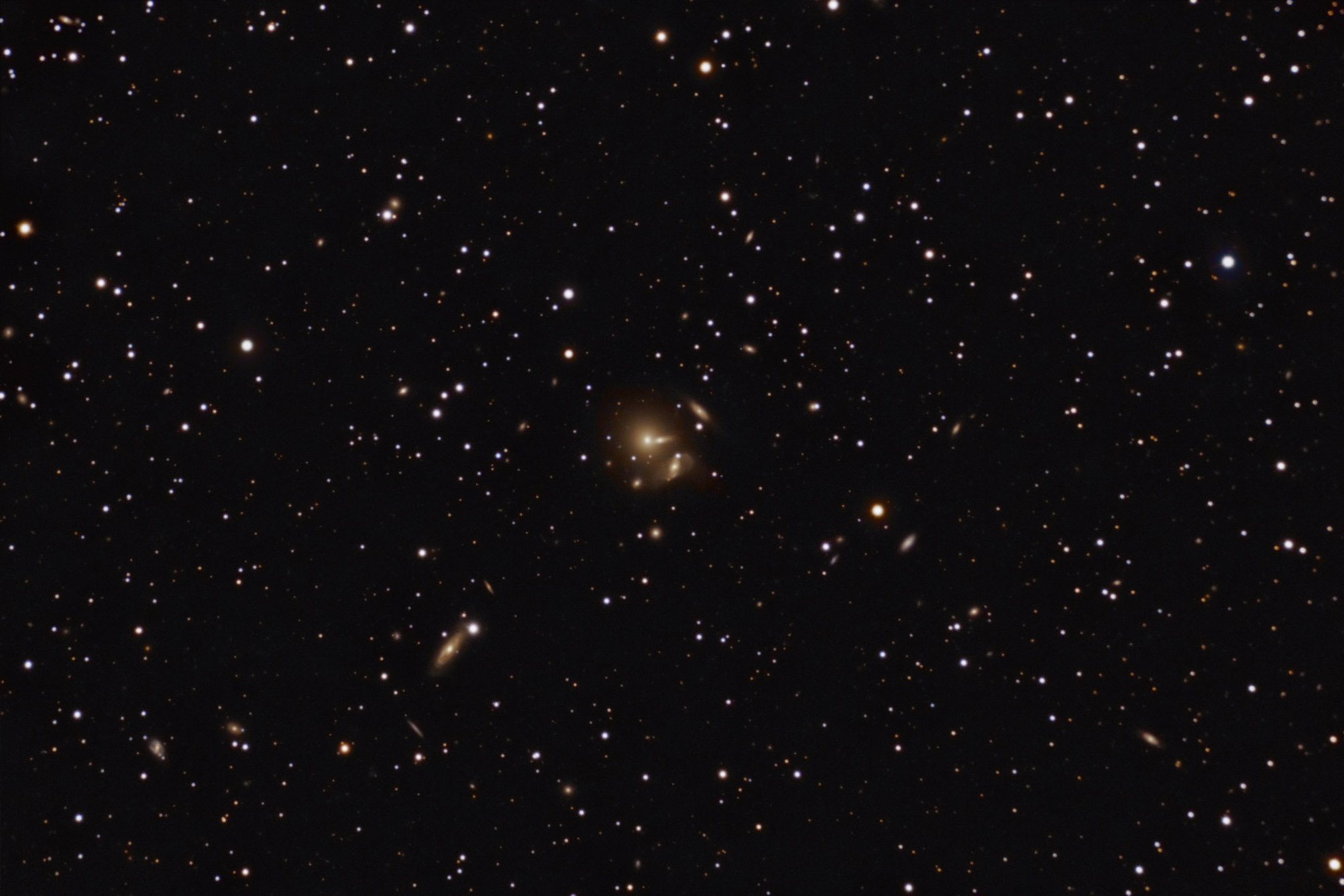Object name: NGC7436Designation(s): NGC7436, NGC7431, NGC7433, NGC7435, UGC12274, NGC 7436 is a pair of galaxies in Pegasus about 330 million light-years away. It and its two companions form a subgroup of the Abell 2513 galaxy cluster. The cluster is centered about 20 minutes west of this group and thus the center of the group is out of my field of view. Oddly, looking at its position on the POSS plates I see what appears to me to be a distant galaxy cluster not noted in NED. NED lists no size for the cluster but few galaxies are seen within 15 minutes of what is shown for the center of Abell 2513 other than these extremely distant galaxies. Most of the members seem to be in my frame, odd for the position of the group is out of the frame. I've marked all that NED has redshift data in my frame and they appear to all be members of the cluster. I marked a couple others that are likely members with their distances shown with a question mark that had no redshift data.
The four galaxies that make up the three NGC members of the group (7436 is two) are cataloged as the "triple" Holmberg 800. I found nothing indicating whether the two members of 7436 are interacting. NGC 7435 does appear to have plumes which have sharp cut offs to the north and south. NEG 7436B, the brightest of the group, has a huge halo. Does this indicate they are interacting? The huge halo of 7436 could be the result of it chowing down on members of the group rather than any current interaction and the plumes of 7435 may be normal for it or the result of some long ago interaction. I found no papers shedding any light on this. Certainly, virtually all members of the group are very red and thus not likely to have had much recent star formation. Those in the annotated image denoted as being in the SRGb catalog are also all strong IR emitters which could indicate hidden star formation. None, however, are listed as having active cores. Red spirals like 7435 are thought to indicate galaxies that have had little star formation for the last few billion years allowing all its blue and white stars to die out without being replaced. In any case, I see little dust in any of the members other than SRGb 016.030 in the southeast corner of the image. It does appear to be a somewhat normal barred spiral with blue arms. AGC 321228 also shows a bluer color than the other members. It though appears to be an edge on spiral without a dust lane though that may be below my resolution.
NGC 7436B is classed as E by NED and the NGC Project. NGC 7436A as S. The NGC project doesn't mention it. NGC 7435 is classed as SB(s)a by NED and SBa by the NGC project. NGC 7433 isn't classed by NED and as S? by the NGC project. I suppose the ? denotes that it could be S0 rather than a true spiral. MCG +04-54-007 is classed by NED as Compact; KUG 2255+258 as spiral and UGC 12274 simply as S. No others in the image were given a classification.
NGC 7431 is a tiny starlike pair of galaxies discovered by Guillaume Bigourdan on September 30, 1886. NGC 7433 and NGC 7435 were found by R.J. Mitchell on October 12, 1855. NGC 7436 was discovered by William Herschel on December 2, 1784. It isn't in either H400 project.
SRGb is the Southern Rich Group - big area catalog in case you were wondering. While the group is north of the celestial equator it is at -30 degrees Using galactic coordinates. It is indeed a southern group just not by the coordinate system we normally use to point our telescopes.
14" LX200R @ f/10, L=4x10' RGB=2x10', STL-11000XM, Paramount ME
Related Designation(s):2MASS J22573859+2609518, 2MASS J22575171+2609438, 2MASS J22575449+2608197, 2MASS J22581959+2603429, 2MASX J22573899+2609517, 2MASX J22575170+2609436, 2MASX J22581956+2603431, 2MASXi J2257389+260951, 2MASXi J2257517+260943, 2MASXi J2257544+260820, 2MASXi J2258195+260343, 2MASXs J2257389+260951, 2MASXs J2257517+260943, 2MASXs J2257517+260944, 2MASXs J2257544+260820, 2MASXs J2257545+260819, 2MASXs J2258195+260343, CALIFA 894, CGCG 2255.4+2554, CGCG 2255.5+2552, CGCG 2255.6+2553, CGCG 2255.9+2548, CGCG 475-006, CGCG 475-007, CGCG 475-008, CGCG 475-011, GALEXASC J225738.66+260951.7 , GALEXASC J225751.61+260942.4 , GALEXMSC J225738.63+260951.8 , GALEXMSC J225751.66+260943.7 , HDCE 1222 NED004, HOLM 800A, HOLM 800B, KAZ 316, LDCE 1552 NED004, LEDA 1765321, MCG +04-54-003, MCG +04-54-004, MCG +04-54-010, NFGS 188, NGC 7431, NGC 7433, NGC 7435, NGC 7436, NGC7431, NGC7433, NGC7435, NGC7436, NPM1G +25.0524, NSA 150355, NSA 150358, NSA 150375, PGC 070112, PGC 070116, PGC 070140, SRGb 016.015, SRGb 016.016, SRGb 016.024, UGC 12267, UGC 12274, UGC12274, USGC U827 NED02, UZC J225754.5+260819, UZC J225819.6+260343, UZC-CG 282 NED04, v2MCG 80:[DMP2012] 2, v2MCG 80:[DMP2012] 3, VV 084, WBL 692-002, WBL 692-003, WBL 692-004, WBL 692-005, | | 
